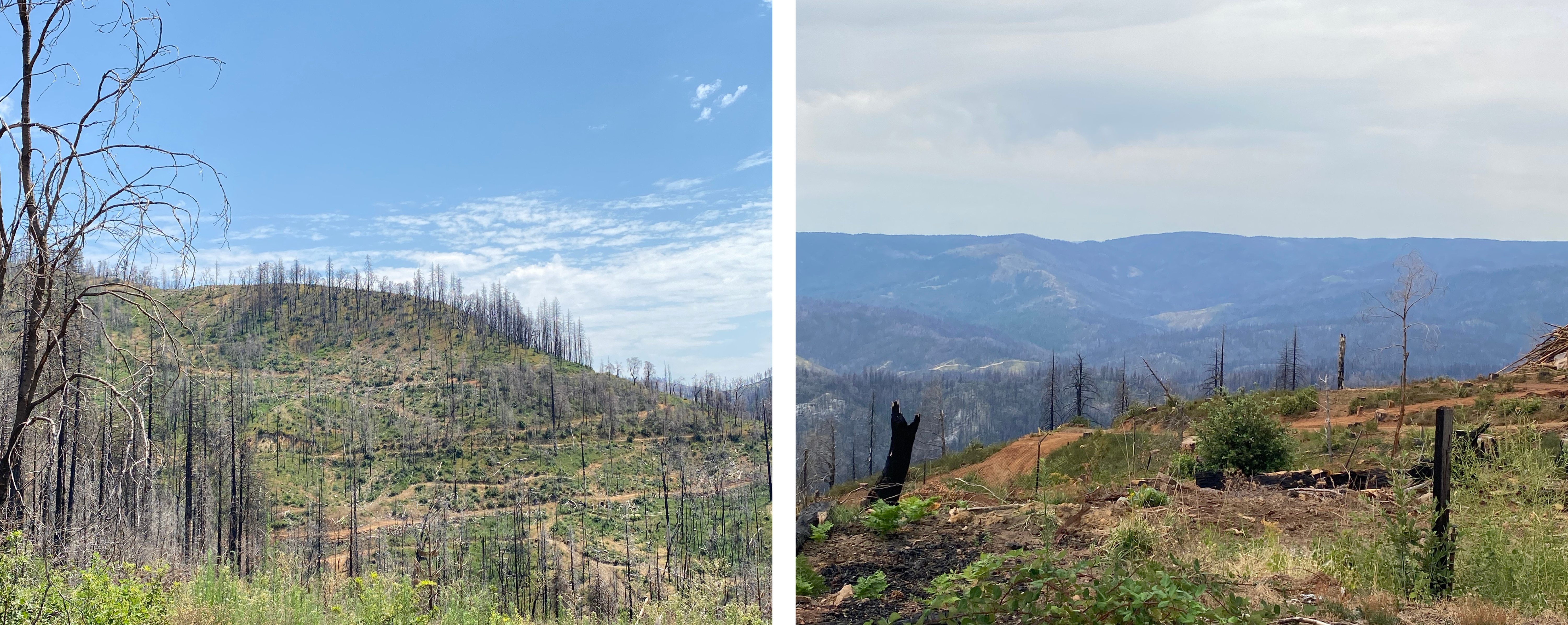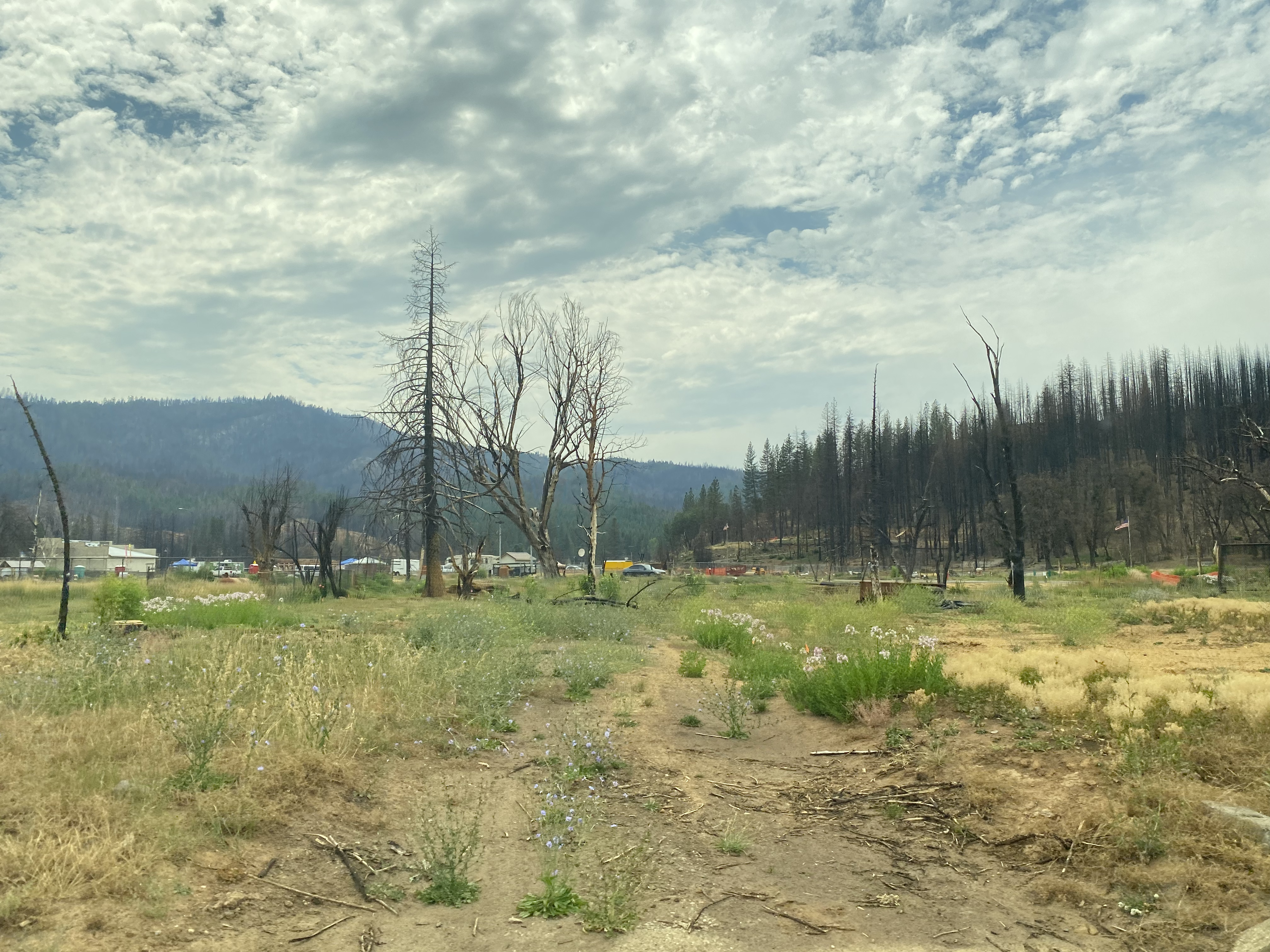By Eli Lewis | This blog is a cross-post and will appear in the Fall 2022 edition of the National Woodlands Magazine.
Last month I had the opportunity to join the USDA Forest Service’s Wildfire Risk Reduction Infrastructure Team (WRRIT) in Northern California. The Forest Service led us on tours of the Plumas National Forest and Tahoe National Forest, highlighting the impacts of the 2021 Dixie Fire (which burned nearly 1 million acres) and the 2020 North Complex Fire (which burned over 300,000 acres).
As we drove from location to location on our tour of the burn scars, miles of blackened forest flashed by my window. Entire mountain sides were scorched, and only tree trunks remained. We also talked with wildland firefighters assigned to the North Complex Fire. They told us that while wildfires are known to move quickly uphill, surprisingly, these wildfires moved just as quickly downhill, taking with them many towns in Northern California. In Greenville, one such town, only a few burned-out structures remain today.
The week I spent with the WRRIT Team helped me to better understand the massive, wide-reaching impacts of wildfires in the region. It also put NASF’s role in supporting wildfire mitigation and suppression efforts nationwide into context.
How the density of trees within a forest exacerbates the likelihood of catastrophic wildfire
The USDA Forest Service employees who met with us emphasized that forest stand density is a significant complicating factor for wildfire management in the state. In Northern California, they said, the forests used to look vastly different.
One study found that across California, tree density in forested regions has increased by 30% between the 1930s and the 2000s, whereas forest biomass in the same regions declined, as indicated by a 19% reduction in basal area. These changes reflect a demographic shift in forest structure: larger trees (>61 cm diameter at breast height) have declined, whereas smaller trees ( < 30 cm) have increased.
Another study by UC Davis and the Forest Service found that mid-elevation, ponderosa pine and mixed conifer forests in California likely had about 60 trees per acre 100 years ago. Today, in stark contrast, the same California forests have between 165 and 170 trees per acre. Yet another study estimates pre-human settlement tree densities in California ranged from 24 to 132 trees per acre, with an average of 66 trees per acre. On those same forests today, tree densities range from 115 to 308 trees per acre, with a mean of 160 trees per acre. These researchers estimate tree densities in the state have increased between 80% and 600% in just 100 years.
Wildfire suppression efforts, while vitally important to protecting human lives and property, have also prevented the natural cycle of burning that many forested ecosystems would ordinarily rely on to regenerate and establish balance. Unfortunately, instead of emulating appropriate and necessary burn cycles in these forests with active forest management, both natural fire regimes and critical management were excluded from these forests for many decades.
In effect, these forests have remained unbalanced—badly lacking the disturbance they need to regenerate with vigor—for upwards of 60 years across the American West. These unbalanced forests are almost without exception what professional foresters call “overstocked,” which means they are too densely occupied with trees. Wildfires in densely stocked forests spread more easily and burn at higher temperatures, which means they are more likely to cause extreme tree mortality and catastrophic damage to forest soils that can’t be reversed. Densely stocked forests are also more susceptible to disease and pests, drought and heat stress, and other risk factors for excessive tree mortality.

Forest management practices, like prescribed fire, thinnings, and timber harvests, can lower wildfire risk for communities while creating fire-adapted ecosystems by ensuring a healthy number of trees per acre. With mechanical thinnings, for instance, forest managers remove some trees in a forest stand to increase resource availability (like sunlight, water, and space) for the more desirable trees that remain. This practice increases the space between trees in a stand, which means wildfires have less fuel and burn with less severity. Thinnings also help strengthen the health and vitality of the trees left in the stand. When a wildfire strikes after a thinning, the biggest trees are more likely to survive the burn and the forest is able to regenerate and maintain long-term resiliency.
By creating fuel breaks, forest managers can slow or stop a wildfire’s progression by removing hazardous fuels in strategically located areas. They also create space to conduct wildfire suppression operations. Prescribed fire is another tool used by natural resource professionals in carefully planned and managed situations to reduce fuel loading. Many forests are fire-adapted ecosystems, so the reintroduction of low-intensity wildfire through prescribed burns enhances regeneration and maintains valuable wildlife habitat, all while reducing wildfire risk.
It will never be an option to allow wildfires to burn indiscriminately in Northern California forests. People living in the wildland-urban interface in the region is only increasing. To let wildfires burn without any suppression or management strategy would spell absolute disaster for those Americans and their communities. For this reason alone, the need for greater forest management in these forests is dire.
Why the “all-lands” approach is the only effective mitigation strategy for wildfires in United States
Another theme of this trip was the importance of an “all-lands” approach to wildland fire and forest management. One Forest Service district ranger on the Plumas explained that if his agency reduces fuels on national forest system (NFS) land, but private landowners or tribes on adjacent lands do not, those mitigative measures would do very little to lessen wildfire severity and damage overall.
At our visit to the town of Greenville, which was burned over by the Dixie Fire, we learned the Forest Service had conducted hazardous fuels treatments on NFS lands near the edge of town, but there had been no coordinated effort to ensure adjacent private lands were also treated. If substantial fuel reduction work had been performed on those adjacent private forest lands, land managers on the ground say the outcome for Greenville would have been different.

In order to best protect communities, fuel treatments are needed on federal and non-federal lands. Cross-boundary fuel treatments complement one another and provide the greatest mitigation benefit to communities. At NASF, the tenets of cooperative forest and wildland fire management are central to our decision making and policy setting. State foresters believe we are most effective at reducing wildfire risk when federal and state agencies, tribes, and partnering organizations collaborate and take an all-lands approach to reducing wildfire risk.
One of the best ways we can work to further mitigate wildfire risk is to empower private landowners with the tools and access to public assistance that they need to implement forest management plans. The Forest Stewardship Program (FSP), administered by the Forest Service and delivered in partnership with state forestry agencies and other partners, is the primary federal mechanism for supporting those landowners in making sustainable management decisions. FSP is also a tool to help landowners reduce wildfire risk.
Forest management plans are often paid for by FSP and provided to landowners free of charge. These plans give landowners a roadmap for reducing excess ground fuels, like dead and downed trees, as well as reducing tree density per acre, which also helps lessen wildfire severity and creates more suitable conditions for prescribed fire treatments. In addition to individual forest management plans, Community Wildfire Protection Plans provide guidance on reducing wildfire risk town-, city- or county-wide.
While the intensity of wildfires is increasing across the U.S., and mitigating their effects has become more challenging, we can still strive to protect our forests and communities. Using the forest management tools and planning resources we have at our disposal, we can make the difference that saves lives.
Eli Lewis is NASF’s policy coordinator. He can be reached by email at elewis@stateforesters.org.

